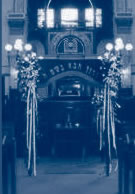|
SEDRA : Vayishlach : HERTZ CHUMASH P.122
Genesis Chap 32. verse 4
This week's Sedra is generously sponsored by Ruth Hampel in memory of the late David Hampel
SYNOPSIS:
Jacob was approaching the land of Israel, so he sent messengers
with a conciliatory message to nearby Edom where his brother
Esau had settled. They returned with the news that Esau was
approaching with four hundred men. Preparing for the worst,
Jacob divided his camp into two parts so that if one were
attacked the other might escape. He also sent a succession
of valuable gifts to Esau in order to ingratiate himself to
him.
That night, Jacob sent his wives and children across the
ford of Jabbok and stayed behind alone to pray. A "man"
appeared and wrestled with him until dawn. Being unable to
overcome Jacob, the man, who was an Angel of G-d, touched
the hollow of his thigh and lamed him. Nevertheless, Jacob
refused to release his opponent from his grasp until he received
a blessing. His wish was granted - henceforth, he would be
called by a new name, Israel, meaning "he that prevails
with G-d". At this time, as a consequence of Jacob's
injury, the law regarding the prohibition of eating "Gid
Hanashe" - the sciatic nerve, was enacted. Jacob now
came face to face with Esau who embraced him with affection.
All his wives and their children were also introduced and
bowed before Esau. Jacob then prevailed upon Esau who accepted
the generous gift he had prepared for him. Sensibly refusing
Esau's offer of an armed escort, Jacob parted from his brother
and eventually reached Schechem where he settled. There he
bought some land, pitched his tent and in gratitude built
an altar to G-d.
Dinah, Jacob's only daughter, was captured and seduced by
Schechem, the son of Hamor, who declared his love for her
and sought Jacob's permission to marry her. Dinah's brothers
intervened and declared that they could not allow intermarriage
or permit trade relationships with the people of Schechem
unless and until the males were circumcised. So deeply in
love was Schechem with Dinah that this condition was readily
accepted. `On the third day' whilst they were in a weak state
and in pain recovering from the operation, Simeon and Levi
(Dinah's brothers) wreaked their revenge by slaying all the
men and despoiling the city. Jacob rebuked his sons but they
justified themselves by asking whether their sister should
be treated like a harlot.
At G-d's bidding, Jacob returned to Bethel where he had made
his vow to G-d concerning his safe return to the land of his
birth. First he buried all the idols in the possession of
his household under an oak tree in Schechem. G-d appeared
to him again, calling his name Israel, and renewed the covenant
to give the land to him and his seed. As they were approaching
Bethlehem, Rachel died in giving birth to Benjamin, and was
buried there. At long last, Jacob reached Hebron where he
was reunited with his father. Isaac died at the age of 180
years and his sons Esau and Jacob buried him.
The Generations of Esau are then enumerated. Esau had become
very wealthy but as there was insufficient land in Canaan
for both he and his brother to tend their flocks and herds,
he took his family and possessions and settled in Mount Seir
in the land of Edom. He became the ancestor of many chieftains
of tribes who settled in that territory.
HAPHTORAH HERTZ CHUMASH P.135 Hosea Chap 11 Verse 7
Jacob's striving with the Angel represents the pinnacle of
his spiritual greatness. The Haphtorah laments Israel's descent
from its high spiritual level.
TELL ME RABBI .... WHY DO WE READ MAFTIR (TWICE)?
The Talmudic sages fixed the rule that the reading of the
Haphtorah could not be done independently of the Torah reading.
The Maftir, the person called up to read from the Prophets,
first had to read a portion from the Torah (Megillah 23a;
Sotah 39b). This Torah portion is now also designated as Maftir,
to distinguish it from the Haphtorah, the reading from the
Prophets. On an ordinary Shabbat, the Maftir consists of rereading
the last few verses (at least three) of the weekly Torah portion.
On the festivals, the Shabbat of Rosh Hodesh, the Shabbat
of Channukah, and on the Four Special Shabbatot that precede
Pesach, the Maftir consists of a special appropriate reading
from another Torah scroll.
The reason given for preceding the Haphtorah with a brief
passage from the Torah is to emphasise "the honour of
the Torah". If the Haphtorah reading were independent
of the Torah reading, and equal honour extended to both, the
erroneous impression might be conveyed that the Torah and
the Prophets are of equal sanctity and authority which is
not so. The books of the Prophets, though a part of the Bible,
are not equal to Torah. By making the reading of the Haphtorah
dependent on first reading a Torah portion, the sages stressed
the notion that while the books of the Prophets are rooted
in Torah, their teachings based on Torah and their Divine
messages intended to strengthen loyalty to the Torah and its
teaching they could not be treated independently of Torah.
For this reason the Maftir is not counted among the official
seven or five aliyot to the Torah on Shabbat or the festivals.
Maftir is an addition to the required number. And while only
someone over Bar Mitzvah may be called to the reading of the
Torah, a child under thirteen may be called upon to read the
Maftir and Haphtorah (except Parshat Zakhor which is regarded
as a Biblical requirement). The status of the Maftir in relation
to the regular Torah reading was thus downgraded. However
since the time that those receiving an aliyah no longer read
the Torah themselves (as used to be the custom) this aliyah
has evolved into a special honour probably because it is the
only aliyah which provides the opportunity of demonstrating
one's proficiency. Persons who merit a special distinction
in the synagogue, or who celebrate a special event in their
lives, are still accorded the honour of reciting the Haphtorah
and its accompanying blessings.
"Shabbat Shalom" is generously sponsored by Rosetta
and Nathan Baron
BACK TO SHABBAT SHALOM
TABLE
|








